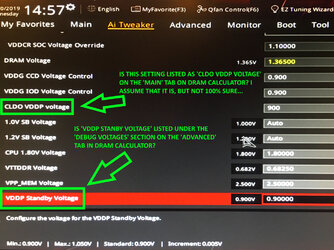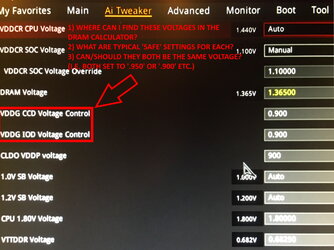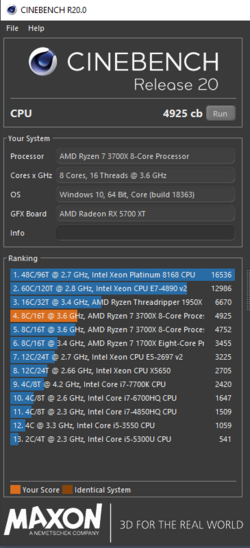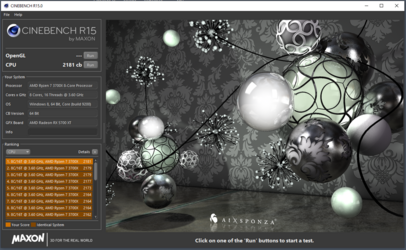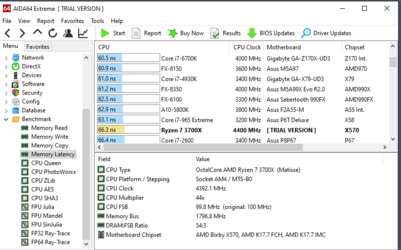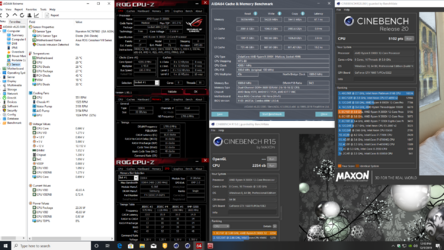- Joined
- Nov 25, 2019
- Location
- United States
((BACKGROUND INFO))
OK… So for the past 2 years, or so, I’ve been learning the ins and outs of overclocking RAM on Ryzen systems. At first I started on a Ryzen 1600 / x370 system but soon upgraded to a Ryzen 2600X and a B450 Tomahawk. I spent the majority of time learning ram overclocking on that particular B450 board and honestly, looking back, I can’t believe just how good that little board is for only $110 US.
Recently, I did a FULL system overhaul and upgraded to a Ryzen 3700 X, an Asus ROG Strix X570-E as well as a few other new components. My main reason for upgrading to these particular parts, was due to x570’s ‘better ram overclocking compatibility’, better power control, and overall better VRM design, among other things. Also, I just wanted a hassle-free motherboard that would instantly boot my new 3700 X without the need to flash the bios.
As soon as I set up my new system and got the basic software/drivers downloaded, I updated to the latest bios, and I began to experiment with Ryzen DRAM calculator. Now, I’ve been using the Dram calculator for a pretty long time (over a year), and I have grown pretty familiar with its different settings and how to properly configure them. Up until now, I’ve had VERY little trouble finding stable / error-free timings and voltages when using the dram calculator. Matter of fact, I only remember a few times that the Dram calc timings did not work on my 2600X/B450 tomahawk setup..and that was usually because I made a mistake when entering the timings in the bios.
((MY ISSUE))
Okay..so over the past few weeks I’ve been attempting to overclock my set of Flare X (Samsung b-die) 3200MHz / CL 14 ram. My original goal was to overclock it to (at least) 3600/CL 14. But TBH, I would even settle for 3600 CL 16 at this point. Or even 3466 CL14.
I’ve literally spent weeks on end working for a few hours each day attempting to successfully overclock this ram and it seems like no matter what I do, or how I can figure the DRAM calculator, or what manual changes I make in the bios settings, I just cannot get this ram to do 3600 MHz without either A) getting errors in memtest … Or B) not even getting my system to post at all.
As of writing this post, the best “overclock“ I am able to achieve it’s 3200 CL 14, with pretty tight sub-timings: 3200 (14-14-14-14-28-42-256)
I’m technically able to overclock a bit higher, to 3333 cl14, but with MUCH looser sub-timings (14-16-16-16-38-56-432) resulting in less performance than my 3200 C14 overclock.
My Flare X ram is rated to run at XMP: 3200 (14-14-14-14-34). So my minor “overclock“ barely affects anything performance-wise, other than a bit of latency reduction.
((QUESTIONS))
1) Am I missing something?? Seriously. Because it feels like I am. I have a good bit of experience OCing memory and I’ve heard basically nothing but good reviews as far as overclocking memory on my particular motherboard - the ASUS ROG STRIX X570-E. I’ve seen posts in overclocking forums of people OCing 3600 CL16 Samsung b-die memory all the way up to 4200MHz+!! Yet I am unable to push my set of b-die past 3200mhz?? Whyyyyyyyyyy??!!

2) I am pretty unfamiliar with the ASUS bios, as most (if not all) of my past motherboards have been MSI. I’ve noticed that ASUS includes 2 separate sections for “AMD overclocking“ and “AMD CBS” (AMD common bios settings?) I’ve also noticed that some of the voltage settings and other misc. settings that appear in the “main bios“ on the ‘AI Tweaker’ page, also appear throughout these 2 separate ‘AMD sections’..Including SOC voltage, VDDP voltage control, VDDG voltage control, and others.
So which section am I supposed to use when setting these various voltages? I’ve been using the voltage settings that appear on the main AI Tweaker page. Is that OK? Or should I be using the ones in the AMD overclocking section?
Ughhhh .. so confusing.
3) Within the ASUS bios, there are also multiple VDDP and VDDG settings. The bios includes: 'VDDG CCD Voltage' and 'VDDG IOD Voltage' settings. However, the DRAM calculator only provides cLDO VDDG and cLDO VDDP voltage recommendations. So, first of all, which DRAM Calculator recommendations should i use for the ASUS bios voltage settings, as they do not have the same "name" as the DRAM Calc. Also, what are these 'new' voltage settings for (VDDG CCD Voltage / VDDG IOD Voltage)? Ive never seen them while OCing on the b450 platform. I'm assuming they have something to do with the IF that runs to the CCD and the other IF that runs to the IOD? But i have no idea, as this is my first time OCing memory on an ASUS board, as well as my first time OCing on the X570 platform. Therefore many of these 'new' x570 settings are still mystery to me.
4) Lastly...to anyone who owns an ASUS X570 board.. or anyone who is familiar with the ASUS bios in general… do you have any tips for me as far as memory overclocking on an Asus motherboard? I honestly thought that this new x570 board would give me much better results when overclocking Samsung b-die. But it’s been about two weeks since I’ve upgraded my system, and as of right now I’m really questioning whether doing so was a good idea or not.
Like I said… I was getting excellent results overclocking my RAM on my crappy little b450 Tomahawk. If I can’t AT LEAST get equal results with the X570 board, then I basically wasted my $330 I spent on it… And that money could’ve gone towards me buying a freaking ROG STRIX 2080 Super instead of a Red Devil 5700 XT lol
So anyway...here are a few of the “fixes“ that I’ve tried:
-Ive tried multiple different VDDG/VDDP voltage settings, including ALL that were recommended by the DRAM Calc - (Min. Rec. & Max,).
-I’ve tried raising/lowering PROCODT resistance.
-I've tried setting SoC voltage to everything from 1.0250v to 1.1v.
-I’ve tried using various CadBus and Termination Die configurations… (Including all of the ones that were provided by the DRAM calculator).
-I’ve tried multiple different tFAW settings, including raising it and lowering it.
-I’ve tried raising tRRDS a bit..raising tRDWR from 6 to 9 and tWRRD to from 1 to 2, 3, 4 etc...
-I’ve tried MANY Different tRFC settings and with each new setting, I made sure to verify that I kept tRC as a multiple of tRFC. (I understand you are supposed to)
((CONCLUSION))
I’ve spent hours and hours tweaking and adjusting my sub-timings, voltages, LLC, etc. But NOTHING seems to work. It’s actually becoming rather disheartening as I think of all the cool **** that $330 could’ve gone towards instead of being spent on this ASUS motherboard lol For Christ’s sake, I could be rocking a STRIX 2080 SUPER ATM instead of my measly little red devil 5700 XT…
But I’m trying to remain positive, and not blame my issues on the motherboard. There’s just got to be something I’m missing. And I feel like it’s probably something minor that I’ve Somehow overlooked… Like maybe some new feature within the X570 bios or something like that..?
I highly doubt my issues are the result of a hardware problem, as my entire system is practically brand spanking new. Though I have considered that maybe my particular set of B-Die sticks just aren't capable of doing 3600 Cl14 for whatever reason...perhaps just bad binning...?
Anyway… If you made it this far then thank you very much for taking the time to read this incredibly long and over-explained post. I will post my full system specs below.
Thanks in advance for any tips/advice you may have for me.
System specs:
CPU: Ryzen 3700X
MOBO: ASUS ROG STRIX X570-E Gaming w/ the latest bios installed (1404)
RAM: FlareX 3200mhz (14-14-14-14-34) (1.35v)
GPU: Red Devil 5700XT
STORAGE: (1) Samsung M.2 nVME 500mb (1) Western Digital WD Blue SSD 1tb
PSU: Corsair Cx650 (650w / 80+ Bronze)
OK… So for the past 2 years, or so, I’ve been learning the ins and outs of overclocking RAM on Ryzen systems. At first I started on a Ryzen 1600 / x370 system but soon upgraded to a Ryzen 2600X and a B450 Tomahawk. I spent the majority of time learning ram overclocking on that particular B450 board and honestly, looking back, I can’t believe just how good that little board is for only $110 US.
Recently, I did a FULL system overhaul and upgraded to a Ryzen 3700 X, an Asus ROG Strix X570-E as well as a few other new components. My main reason for upgrading to these particular parts, was due to x570’s ‘better ram overclocking compatibility’, better power control, and overall better VRM design, among other things. Also, I just wanted a hassle-free motherboard that would instantly boot my new 3700 X without the need to flash the bios.
As soon as I set up my new system and got the basic software/drivers downloaded, I updated to the latest bios, and I began to experiment with Ryzen DRAM calculator. Now, I’ve been using the Dram calculator for a pretty long time (over a year), and I have grown pretty familiar with its different settings and how to properly configure them. Up until now, I’ve had VERY little trouble finding stable / error-free timings and voltages when using the dram calculator. Matter of fact, I only remember a few times that the Dram calc timings did not work on my 2600X/B450 tomahawk setup..and that was usually because I made a mistake when entering the timings in the bios.
((MY ISSUE))
Okay..so over the past few weeks I’ve been attempting to overclock my set of Flare X (Samsung b-die) 3200MHz / CL 14 ram. My original goal was to overclock it to (at least) 3600/CL 14. But TBH, I would even settle for 3600 CL 16 at this point. Or even 3466 CL14.
I’ve literally spent weeks on end working for a few hours each day attempting to successfully overclock this ram and it seems like no matter what I do, or how I can figure the DRAM calculator, or what manual changes I make in the bios settings, I just cannot get this ram to do 3600 MHz without either A) getting errors in memtest … Or B) not even getting my system to post at all.
As of writing this post, the best “overclock“ I am able to achieve it’s 3200 CL 14, with pretty tight sub-timings: 3200 (14-14-14-14-28-42-256)
I’m technically able to overclock a bit higher, to 3333 cl14, but with MUCH looser sub-timings (14-16-16-16-38-56-432) resulting in less performance than my 3200 C14 overclock.
My Flare X ram is rated to run at XMP: 3200 (14-14-14-14-34). So my minor “overclock“ barely affects anything performance-wise, other than a bit of latency reduction.
((QUESTIONS))
1) Am I missing something?? Seriously. Because it feels like I am. I have a good bit of experience OCing memory and I’ve heard basically nothing but good reviews as far as overclocking memory on my particular motherboard - the ASUS ROG STRIX X570-E. I’ve seen posts in overclocking forums of people OCing 3600 CL16 Samsung b-die memory all the way up to 4200MHz+!! Yet I am unable to push my set of b-die past 3200mhz?? Whyyyyyyyyyy??!!
2) I am pretty unfamiliar with the ASUS bios, as most (if not all) of my past motherboards have been MSI. I’ve noticed that ASUS includes 2 separate sections for “AMD overclocking“ and “AMD CBS” (AMD common bios settings?) I’ve also noticed that some of the voltage settings and other misc. settings that appear in the “main bios“ on the ‘AI Tweaker’ page, also appear throughout these 2 separate ‘AMD sections’..Including SOC voltage, VDDP voltage control, VDDG voltage control, and others.
So which section am I supposed to use when setting these various voltages? I’ve been using the voltage settings that appear on the main AI Tweaker page. Is that OK? Or should I be using the ones in the AMD overclocking section?
Ughhhh .. so confusing.
3) Within the ASUS bios, there are also multiple VDDP and VDDG settings. The bios includes: 'VDDG CCD Voltage' and 'VDDG IOD Voltage' settings. However, the DRAM calculator only provides cLDO VDDG and cLDO VDDP voltage recommendations. So, first of all, which DRAM Calculator recommendations should i use for the ASUS bios voltage settings, as they do not have the same "name" as the DRAM Calc. Also, what are these 'new' voltage settings for (VDDG CCD Voltage / VDDG IOD Voltage)? Ive never seen them while OCing on the b450 platform. I'm assuming they have something to do with the IF that runs to the CCD and the other IF that runs to the IOD? But i have no idea, as this is my first time OCing memory on an ASUS board, as well as my first time OCing on the X570 platform. Therefore many of these 'new' x570 settings are still mystery to me.
4) Lastly...to anyone who owns an ASUS X570 board.. or anyone who is familiar with the ASUS bios in general… do you have any tips for me as far as memory overclocking on an Asus motherboard? I honestly thought that this new x570 board would give me much better results when overclocking Samsung b-die. But it’s been about two weeks since I’ve upgraded my system, and as of right now I’m really questioning whether doing so was a good idea or not.
Like I said… I was getting excellent results overclocking my RAM on my crappy little b450 Tomahawk. If I can’t AT LEAST get equal results with the X570 board, then I basically wasted my $330 I spent on it… And that money could’ve gone towards me buying a freaking ROG STRIX 2080 Super instead of a Red Devil 5700 XT lol
So anyway...here are a few of the “fixes“ that I’ve tried:
-Ive tried multiple different VDDG/VDDP voltage settings, including ALL that were recommended by the DRAM Calc - (Min. Rec. & Max,).
-I’ve tried raising/lowering PROCODT resistance.
-I've tried setting SoC voltage to everything from 1.0250v to 1.1v.
-I’ve tried using various CadBus and Termination Die configurations… (Including all of the ones that were provided by the DRAM calculator).
-I’ve tried multiple different tFAW settings, including raising it and lowering it.
-I’ve tried raising tRRDS a bit..raising tRDWR from 6 to 9 and tWRRD to from 1 to 2, 3, 4 etc...
-I’ve tried MANY Different tRFC settings and with each new setting, I made sure to verify that I kept tRC as a multiple of tRFC. (I understand you are supposed to)
((CONCLUSION))
I’ve spent hours and hours tweaking and adjusting my sub-timings, voltages, LLC, etc. But NOTHING seems to work. It’s actually becoming rather disheartening as I think of all the cool **** that $330 could’ve gone towards instead of being spent on this ASUS motherboard lol For Christ’s sake, I could be rocking a STRIX 2080 SUPER ATM instead of my measly little red devil 5700 XT…
But I’m trying to remain positive, and not blame my issues on the motherboard. There’s just got to be something I’m missing. And I feel like it’s probably something minor that I’ve Somehow overlooked… Like maybe some new feature within the X570 bios or something like that..?
I highly doubt my issues are the result of a hardware problem, as my entire system is practically brand spanking new. Though I have considered that maybe my particular set of B-Die sticks just aren't capable of doing 3600 Cl14 for whatever reason...perhaps just bad binning...?
Anyway… If you made it this far then thank you very much for taking the time to read this incredibly long and over-explained post. I will post my full system specs below.
Thanks in advance for any tips/advice you may have for me.
System specs:
CPU: Ryzen 3700X
MOBO: ASUS ROG STRIX X570-E Gaming w/ the latest bios installed (1404)
RAM: FlareX 3200mhz (14-14-14-14-34) (1.35v)
GPU: Red Devil 5700XT
STORAGE: (1) Samsung M.2 nVME 500mb (1) Western Digital WD Blue SSD 1tb
PSU: Corsair Cx650 (650w / 80+ Bronze)
